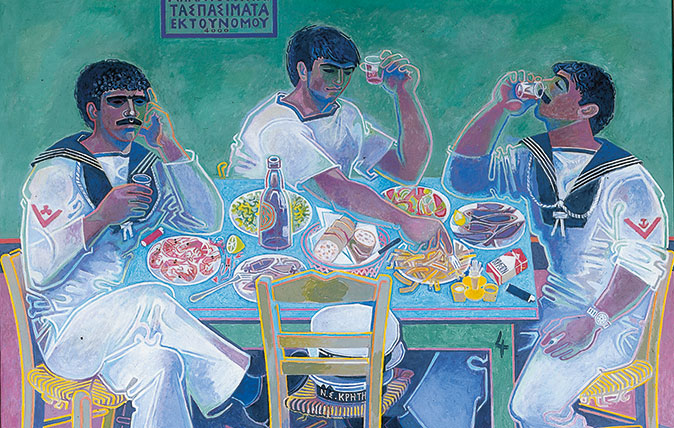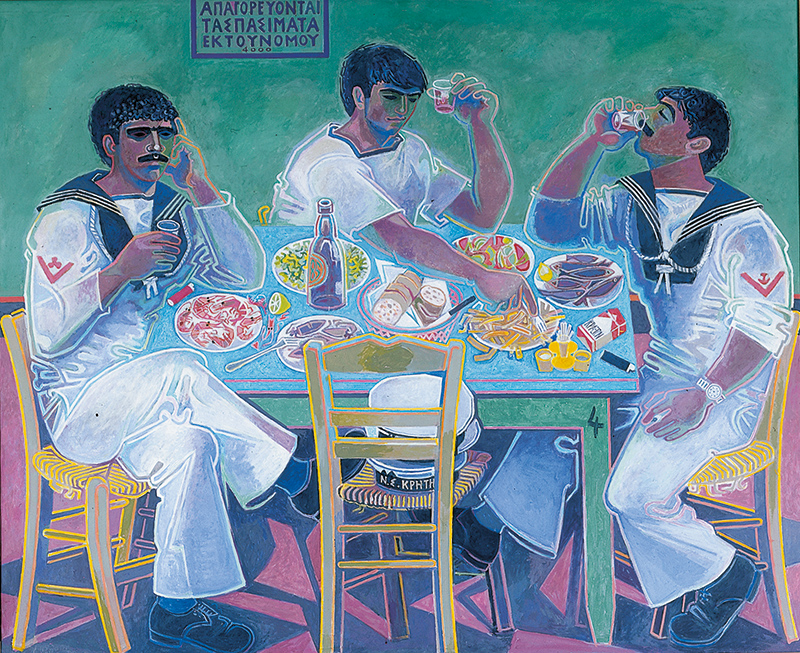In Focus: The charmed life of Paddy Leigh Fermor and friends in Greece
The iconic writer Paddy Leigh Fermor and two of his friends in Greece – both artists, one a local man and the other a fellow Brit – are the subject of a fascinating exhibition at the British Museum. Chloe-Jane Good paid a visit.


Upon entering the British Museum in the tidal wave of visitors intent on Rodin and the art of ancient Greece – the museum’s magnificent summer show – dive out left and head for Room 5, the free exhibition gallery. In this quiet southern tip of the museum building you will find Charmed lives in Greece: Ghika, Craxton, Leigh Fermor, the enchanting story of the friendship of three men and their shared love of Greece; Greek artist Nikos Hadjikyriakos-Ghika, and the Englishmen, artist John Craxton and writer Patrick Leigh Fermor.
The exhibition includes drawings and paintings of Greece by Gika and Craxton; book-cover designs by Craxton for Leigh Fermor publications; letters; Leigh Fermor’s typewriter; and photographs by his wife, Joan Raynor.
Leigh Fermor and Craxton both left England in search of sun, colour, and in the case of Leigh Fermor, adventure. The latter was just 18 when, in 1933, he set off on an epic journey by foot covering the length of Europe from Holland to Istanbul where he arrived in 1935. He was to write about the experience in his later travel books, A Time of Gifts (1977), Between the Woods and the Water (1986) and the posthumously-published The Broken Road.
Craxton was born in London in the early 1920s to a Bohemian musical family. His father Harold Craxton was a highly regarded pianist and composer and professor at the Royal Academy of Music. His sister was the distinguished oboist Janet Craxton. Meals at home were busy affairs centred on music, often involving impromptu guests such as Harold’s students and fellow musicians.
In 1937, aged 14, Craxton was taken by a friend's father, the then owner of El Greco’s An Allegory (Fàbula), to the Paris International Exposition to see Picasso's newly painted Guernica. It was a formative moment for Craxton, who later confessed he did not fully appreciate the human atrocity portrayed in the painting but rather was deeply impressed by the power of paint.
Craxton spent some of his teens in Dorset with his uncle and aunt who were both artists. There he found a space where he could become an artist of his own kind away from the music centric environment of his family home. He made dark haunting depictions of the countryside using little colour, if any, and was greatly influenced by William Blake.
"It is as though they are spinning around together in a dance"
He returned to Paris in 1939 to study life drawing at the Académie de la Grande Chaumière and from 1941-42 attended Goldmiths College. His first major solo exhibition was at Leicester Galleries in London where he met Joan Rayner and Ghika, who also exhibited with the gallery. The group soon became friends and gathered on Hydra as guests of Ghika’s impressive family house. The group was to attract many interesting visitors to Greece over the years including Winston Churchill and Margot Fonteyn.
Sign up for the Country Life Newsletter
Exquisite houses, the beauty of Nature, and how to get the most from your life, straight to your inbox.
Greece was the escape Craxton so wished for far from the bleakness of post-war England. He put it this way: ‘I have little sense of being “British”. In Greece I found human identities, people within their own environment. This new world fitted me artistically, and suited me socially and financially.’
In love with the Greek way of life, he settled in Crete in 1960 and set up studio. He wholeheartedly enjoyed eating and socialising in tavernas with local people and sailors who blew in and got them to sit for him.
In Still Life with Three Sailors, 1980-85, we see the joy the artist took in these encounters. There is a musicality and raucousness in the arrangement of the figures and table still lifes. It is as though they are spinning around together in a dance. The energy, movement and Fauvist palette bring to mind Matisse’s Dance painted in the early 1900s.
Like Matisse and Dance, Craxton spent many years making alterations to his painting to achieve the final effect. The outer contours became neon and the vibrant energy increased.
David Attenborough, a collector of Craxton’s work and friend of the artist, remembers with amusement how Craxton never really finished a painting. When Craxton visited him at home, the artist would remove his pictures from the wall and take them off for modifications before reluctantly returning them.
Craxton’s Greece paintings are a record of a life well-lived. He is quoted as saying, 'I can work best in an atmosphere where life is considered more important than art – where life is in itself an art. Then I find it's possible to feel a real person – real people, real elements, real windows – real sun above all.’
Charmed lives in Greece: Ghika, Craxton, Leigh Fermor is at the British Museum until July 15
-
 Two quick and easy seasonal asparagus recipes to try this Easter Weekend
Two quick and easy seasonal asparagus recipes to try this Easter WeekendAsparagus has royal roots — it was once a favourite of Madame de Pompadour.
By Melanie Johnson
-
 Sip tea and laugh at your neighbours in this seaside Norfolk home with a watchtower
Sip tea and laugh at your neighbours in this seaside Norfolk home with a watchtowerOn Cliff Hill in Gorleston, one home is taller than all the others. It could be yours.
By James Fisher